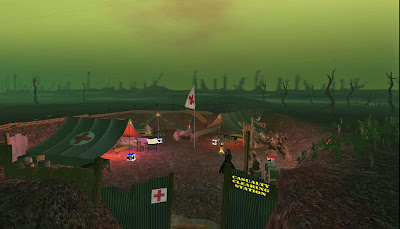Mrs. Kuhr has a very nice discussion of what worked and what did not, from the perspective of someone who actually knows what she's talking about. My notes are much more from the perspective of someone who is vaguely aware that, to have a Second World War, one logically needed a First. (All right, I'm not quite that ignorant, but nearly so.)
One can also read about the exhibit here.
The billboard at the landing area notes: "The aim of the initiative is to place the poetry of the Great War in context, allowing the visitors to the sim to visualise archival materials in an environment that generates deeper understandings and to take advantage of the social and interactive aspects that the environment offers."

To a large degree, I think it succeeds. One starts at a "training camp" (Miz Dio notes that this is really supposed to be the British army base at Etaples, which turns out to be a town in northern France that was the home of the British Expeditionary Force, rather than a large chain of office supply stores) and learns of conditions at the camp and how soldiers were trained in warfare, including how to dig trenches and deal with gas attacks.

After leaving the camp, one travels to the battlefield in a mysterious conveyance that moves the observer through the clouds, first above and then below airplanes patrolling the skies, and finally to the ground. As the sign above shows, one is not yet at the front (but England is most assuredly in the other direction).

The Casualty Clearing Station, pictured above, was where medical attention, such as it was, could be given. Soldiers were patched up as best as possible and sent back to the front.

One moves among the trenches, unable to see out, as artillery explodes nearby. At one point, the effects of a mustard gas attack are shown. Barbed wire fences separate the trenches into a "no man's land" where travel is hazardous to one's health, being exposed to small arms and artillery fire from both sides. (I kept my head down.)

As I noted above, I'm no expert in the subject. To this novice, I thought the experience was interesting because it conveyed a visual sense of the conditions under which the soldiers on both sides operated. As Miz Dio put it, the experience "can never really recreate the true feeling of [trench warfare]. The smell of death and shit, the mud and the dirt, the threat of actually getting killed..." But it convinced me not to wind up as a soldier in a trench.
I think it's great that groups are starting to consider how to use virtual worlds to convey information that would be difficult to convey in other ways. To use a more prosaic example, seeing a picture of a dress from the 1870s with an enormous bustle is one thing, but it's quite another to see an avatar walking in one. I hope other educational groups use SL in similarly inventive ways; it strikes me that this is a great deal more plausible than SL as a tool for real-world business meetings, as I occasionally read is the goal of the Lab.
(N.B., the title of this journal entry is from a poem by Seigfried Sassoon.)
2 comments:
Oh... my. The pictures of the sim are stunning. Thank you for blogging this, I wouldn't have otherwise known another someplace amazing has opened that just must be seen. I am mildly knowledgeable about the First World War, but no expert. I'll never forget the comment that a military history professor made, though... there is no "first" world war and no "second" world war -- it was all one huge, long war where the combatants realized they had to rest and produce another generation before they could continue slaughtering each other.
Thakn you again,
Ghilayne Andrew,
New Babbage
Thank you for the kind words, Miss Andrew. And I agree, it's a sobering presentation.
I was once told that periodic nasty wars were society's way of getting rid of the excess, unattached young men that would otherwise create mischief at home. I think that was only half a joke. :)
Post a Comment